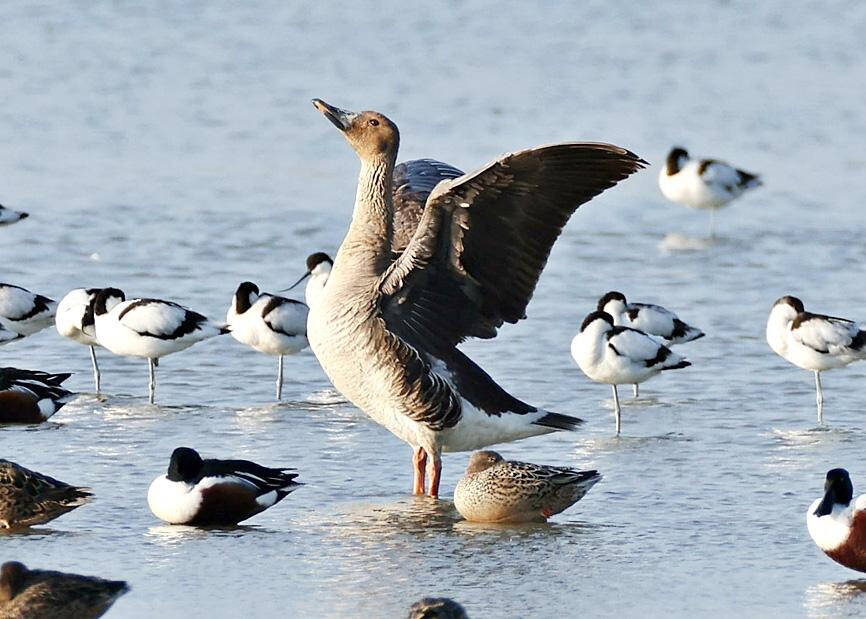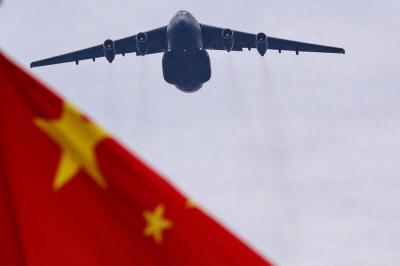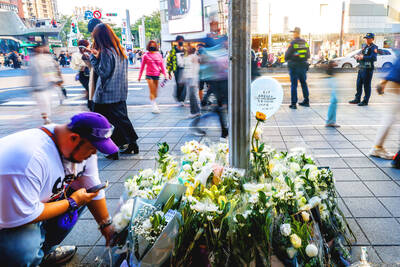Research by the Ministry of Agriculture’s Taiwan Biodiversity Research Institute suggests that the richness of bird species increases with landscape heterogeneity.
A research team from the institute analyzed how landscape heterogeneity and total habitat area affect the number of bird species based on data from the Taiwan Breeding Bird Survey.
The results showed a significant hump-shaped association of bird species with forest and farmland coverage, meaning that a balanced proportion of diverse land cover types, such as a mixture of farms and forests, would attract the most bird species, the institute said.

Photo courtesy of the Cieding Visitors’ Association
For example, the Tianliaoyang Wetland (田寮洋濕地) in New Taipei City and its surrounding forests have documented visits of more than 100 bird species within a single day every year, it said.
For forest birds, the number of bird species rose with the total area of forests regardless of the size of the survey area, which ranged from a radius of 100m and 500m to 1km and 2km, the institute said.
However, the richness of farmland birds increased significantly with the total farmland area only when the survey area was limited to a radius of 100m, it said.
“Within a radius of 100m, farmland boosts bird species diversity, whether it is a single large farm or multiple small farms,” the institute said.
The results also showed that Taiwan’s alien bird species, or introduced birds, preferred fragmented landscapes, as their richness increased with edge density, an indicator used to measure the configurational heterogeneity of a landscape, it said.
The team is now researching frog habitats using the same method to examine whether frog species diversity is also significantly linked to landscape heterogeneity, the institute said, adding that the goal is to propose a more comprehensive strategy to help preserve biodiversity.

Beijing could eventually see a full amphibious invasion of Taiwan as the only "prudent" way to bring about unification, the US Department of Defense said in a newly released annual report to Congress. The Pentagon's "Annual Report to Congress: Military and Security Developments Involving the People's Republic of China 2025," was in many ways similar to last year’s report but reorganized the analysis of the options China has to take over Taiwan. Generally, according to the report, Chinese leaders view the People's Liberation Army's (PLA) capabilities for a Taiwan campaign as improving, but they remain uncertain about its readiness to successfully seize

HORROR STORIES: One victim recounted not realizing they had been stabbed and seeing people bleeding, while another recalled breaking down in tears after fleeing A man on Friday died after he tried to fight the knife-wielding suspect who went on a stabbing spree near two of Taipei’s busiest metro stations, Taipei Mayor Chiang Wan-an (蔣萬安) said. The 57-year-old man, identified by his family name, Yu (余), encountered the suspect at Exit M7 of Taipei Main Station and immediately tried to stop him, but was fatally wounded and later died, Chiang said, calling the incident “heartbreaking.” Yu’s family would receive at least NT$5 million (US$158,584) in compensation through the Taipei Rapid Transit Corp’s (TRTC) insurance coverage, he said after convening an emergency security response meeting yesterday morning. National

Taiwan has overtaken South Korea this year in per capita income for the first time in 23 years, IMF data showed. Per capita income is a nation’s GDP divided by the total population, used to compare average wealth levels across countries. Taiwan also beat Japan this year on per capita income, after surpassing it for the first time last year, US magazine Newsweek reported yesterday. Across Asia, Taiwan ranked fourth for per capita income at US$37,827 this year due to sustained economic growth, the report said. In the top three spots were Singapore, Macau and Hong Kong, it said. South

PLANNED: The suspect visited the crime scene before the killings, seeking information on how to access the roof, and had extensively researched a 2014 stabbing incident The suspect in a stabbing attack that killed three people and injured 11 in Taipei on Friday had planned the assault and set fires at other locations earlier in the day, law enforcement officials said yesterday. National Police Agency (NPA) Director-General Chang Jung-hsin (張榮興) said the suspect, a 27-year-old man named Chang Wen (張文), began the attacks at 3:40pm, first setting off smoke bombs on a road, damaging cars and motorbikes. Earlier, Chang Wen set fire to a rental room where he was staying on Gongyuan Road in Zhongzheng District (中正), Chang Jung-hsin said. The suspect later threw smoke grenades near two exits